#lapland war
Text

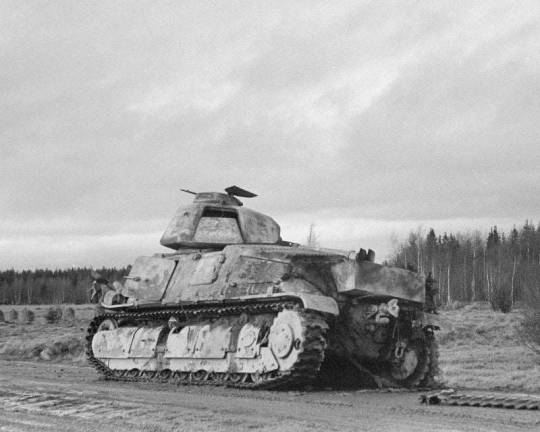
German Somua S-35s, destroyed by Finnish troops during a skirmish on the Kemi-Tornio road during the Lapland War, 1944
39 notes
·
View notes
Text
i think one of the funniest things i've seen on this site was someone saying that Tom of Finland fought against the nazis...like oh baby no...i have some very bad news for you LOL
#like i regret to inform you that finland fought *with* the nazis#(with the exception of the lapland war but that was its own thing)
3 notes
·
View notes
Text
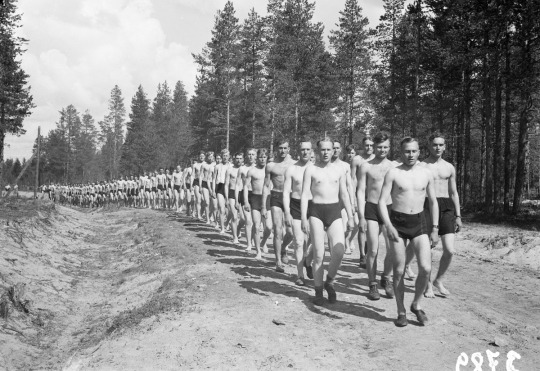


German army in Northern Finland during the Second World War.
© Museovirasto
#history#second world war#wwii#ww2#lapland#german army#wehrmacht#german soldiers#photograph#black and white
2 notes
·
View notes
Text
The war was the result of ongoing disputes over trade routes, due to Denmark–Norway controlling a monopoly through the strait between the Baltic Sea and the North Sea.
King Christian IV of Denmark and Norway protested to the Swedish King, Charles IX, but his protests over the new route was ignored. Finally, in April 1611, in response to Sweden’s claim of a traditionally Norwegian area in Northern Norway, Denmark-Norway declared war upon Sweden and invaded.
Sweden sought to establish an alternate route through Lapland to avoid paying a toll on the use of the Øresund, or “Sound” strait, a toll that constituted up to two thirds of Denmark’s state income in the 16th and 17th centuries.
#history#archeology#archeologicalsite#discovery#sweeden#denmark#ancient kingdom#war#17th century#trade routes#Lapland#norway
2 notes
·
View notes
Text
Sisu - Movie Review
TL;DR – An electric meditation on violence and the lengths people will go to survive.
⭐⭐⭐⭐⭐
Rating: 4.5 out of 5.
Post-Credit Scene – There is no post-credit scene.Disclosure – I paid to see this film.
Sisu Review –
Violence can be used for many things in cinema. It can be shocking, used for humour, tell a moral, used to scare, or even offend. Recently, we have seen the popularisation of the…

View On WordPress
#Action#Aksel Hennie#Arttu Kapulainen#Finish Cinema#Finland#Ilkka Koivula#Jack Doolan#Jorma Tommila#Lapland#Max Ovaska#Military#Mimosa Willamo#Onni Tommila#Scandinavian Cinema#Sisu#Tatu Sinisalo#War#Wilhelm Enckell#WW2
1 note
·
View note
Text

Just watched the movie Sisu (2023). I loved it. Main character was such a badass he didnt even speak until the final scene right before the credits. lol he just got the job done.
3 notes
·
View notes
Text
REVIEW: Sisu (2023)
A Film By Jalmari Helander
As an avid fan of historical films, I was eagerly anticipating the release of Sisu a few weeks ago. A co-production of American and Finnish film companies, Sisu is a genre-bending film that blends the gritty action of George Miller’s “Mad Max” with the stylized violence of a Quentin Tarantino flick, all while drawing on the story beats of the now iconic John Wick…

View On WordPress
#Finland#Germany#History#Jalmari Helander#Movie#Movie Review#Nazis#Russia#Sisu#The lapland War#USSR#Winter War#World War II#WWII
0 notes
Photo
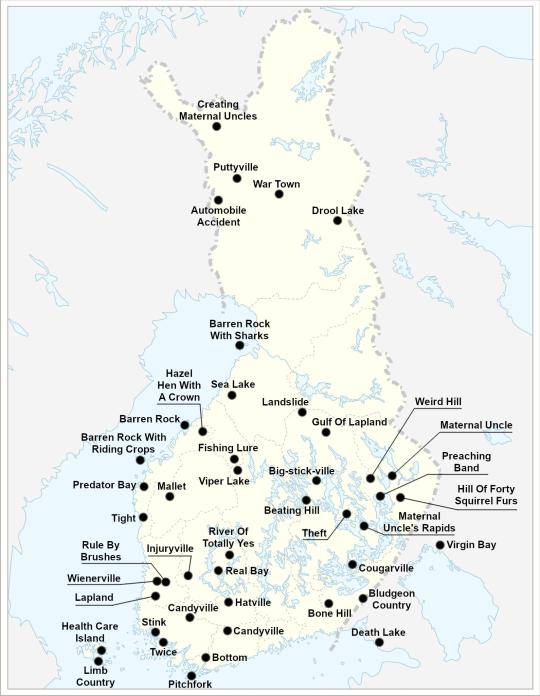
Names of some Finnish municipalities (current and former) translated literally to English.
by u/Rascally_Raccoon
Automobile Accident – Kolari
Barren Rock – Luoto
Barren Rock With Riding Crops – Raippaluoto
Barren Rock With Sharks – Hailuoto
Beating Hill – Pieksämäki
Big-stick-ville – Karttula
Bludgeon Country – Nuijamaa
Bone Hill – Luumäki
Bottom – Pohja
Candyville – Karkkila
Candyville – Mellilä
Cougarville – Puumala
Creating Maternal Uncles – Enontekiö
Death Lake – Kuolemajärvi
Drool Lake – Kuolajärvi
Fishing Lure – Perho
Gulf Of Lapland – Lapinlahti
Hatville – Hattula
Hazel Hen With A Crown – Kruunupyy
Health Care Island – Vårdö
Hill Of Forty Squirrel Furs – Kiihtelysvaara
Injuryville – Vammala
Landslide – Vieremä
Lapland – Lappi
Limb Country – Lemland
Mallet – Kurikka
Maternal Uncle – Eno
Maternal Uncle’s Rapids – Enonkoski
Pitchfork – Hanko
Preaching Band – Liperi
Predator Bay – Petolahti
Puttyville – Kittilä
Real Bay – Aitolahti
River of Totally Yes – Juupajoki
Rule By Brushes – Harjavalta
Sea Lake – Merijärvi
Stink – Lemu
Theft – Varkaus
Tight – Tiukka
Twice – Kakskerta
Viper Lake – Kyyjärvi
Virgin Bay – Impilahti
War Town – Sodankylä
Weird Hill – Outokumpu
Wienerville – Nakkila
1K notes
·
View notes
Text
The Four Failed Events of the Apocalypse:
-Pestilence: Lapland New Forest
-Famine: Wonka Experience Glasgow
-War: Fyre Festival
-Death: Dashcon
23 notes
·
View notes
Text

The Finnish Border Guard celebrates its 105th anniversary today.
Colonel A. Pennanen, October 26, 1941.
Antti Pennanen (1903-1989) served as the commander of Detachment Pennanen in Petsamo during the Winter War. In the Continuation War, he was responsible for the same area as the commander of the so-called Men of Lutto of the Separate Detachment Petsamo (Er.Os.P). In the Lapland War, Pennanen and his men saved, among other things, the nationally important industrial facilities in Kemi.
After the wars, Pennanen served as the commander of the Lapland Border Guard and later as the chief of the Border Guards, rising to the rank of lieutenant general.
••••••••
Rajavartiolaitos viettää tänään 105. vuosipäiväänsä.
Eversti A.Pennanen, 26.10.1941.
Antti Pennanen (1903-1989) toimi talvisodassa Petsamossa osasto Pennasen komentajana. Jatkosodassa Pennanen oli vastuussa samalla alueella Petsamon erillisosaston ns. Luton Miesten komentajana. Lapin sodassa Pennanen miehineen pelasti muun muassa Kemin valtakunnallisesti tärkeät teollisuuslaitokset.
Sotien jälkeen Pennanen toimi Lapin rajavartioston komentajana ja myöhemmin rajavartiostojen päällikkönä kohoten kenraaliluutnantiksi asti.
••••••••
[ sa-kuva | 61348 | H. Roivainen ]
#wwii#jhlcolorizing#wwii history#colorizing#ww2history#suomi#finland#worldwar2#worldwartwo#ww2photos#wwiihistory#ww2 worldwar2 wwii#worldwar#rajavartiolaitos#war history#historia#world war 2#war#suomisodassa#colourized#colourised#colorized
14 notes
·
View notes
Photo
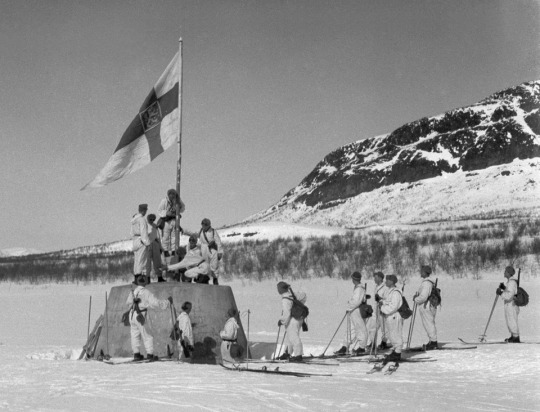
Finnish soldiers raise the flag at the three-country cairn between Norway, Sweden and Finland after the end of the Lapland War. 27 April 1945
25 notes
·
View notes
Text
I finally took the time to finish (pardon the pun) reading the Kalevala Crawford translation! Here's the link to the online cache, for those interested.

One of my favorite passages:
Lemminkainen, much dejected,
Broken-hearted, flushed with anger,
Spake these words in measured accents:
“Mother dear, my gray-haired mother,
Wilt thou straightway wash my linen
In the blood of poison-serpents,
In the black blood of the adder?
I must hasten to the combat,
To the camp-fires of the Northland,
To the battle-fields of Lapland;
To the village went Kyllikki,
To the play of merry maidens,
To the games and village dances,
With the maids of braided tresses.”
Straightway speaks the wife, Kyllikki:
“My beloved husband, Ahti,
Do not go to war, I pray thee.
In the evening I lay sleeping,
Slumbering I saw in dream-land
Fire upshooting from the chimney,
Flames arising, mounting skyward,
From the windows of this dwelling,
From the summits of these rafters,
Piercing through our upper chambers,
Roaring like the fall of waters,
Leaping from the floor and ceiling,
Darting from the halls and doorways.”
#kalevala#finnish culture#finno-ugric peoples#sources#culture#ressources#poetry#folklore#history#historical#research#paganism#writings
20 notes
·
View notes
Text
Finnish book recommendations #6
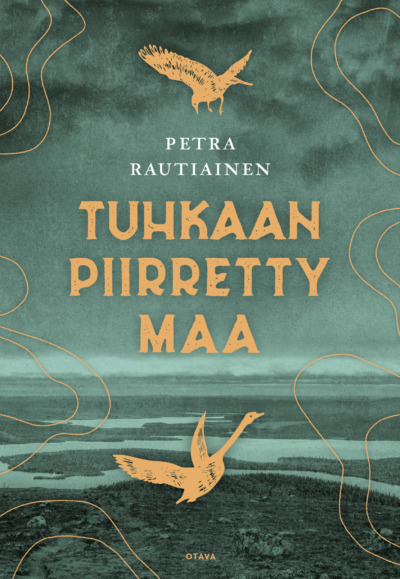
Petra Rautiainen - Tuhkaan piirretty maa
(Country drawn in ash, English title: Land of snow and ashes)
Finnish Lapland, 1944: a young Finnish soldier is called to work as an interpreter at a Nazi prison camp. Surrounded by cruelty and death, he struggles to hold on to his humanity. When peace comes, the crimes are buried beneath the snow and ice.
A few years later, journalist Inkeri is assigned to investigate the rapid development of remote Western Lapland. Her real motivation is more personal: she is following a lead on her husband, who disappeared during the war.
But the villagers don’t want to dwell on the past, and Inkeri’s questions provoke hostility and suspicious silences. As she learns more about her mysterious tenant, Olavi, and tries to befriend a young Sámi girl, she begins to uncover traces of disturbing facts that were never supposed to come to light.
From this starkly beautiful polar landscape emerges a story of silenced histories and ongoing oppression, of human brutality and survival.
29 notes
·
View notes
Text

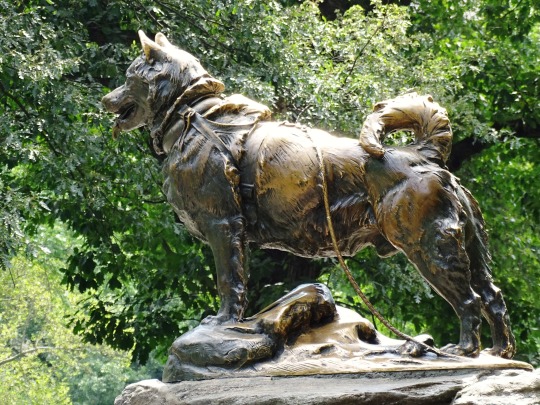


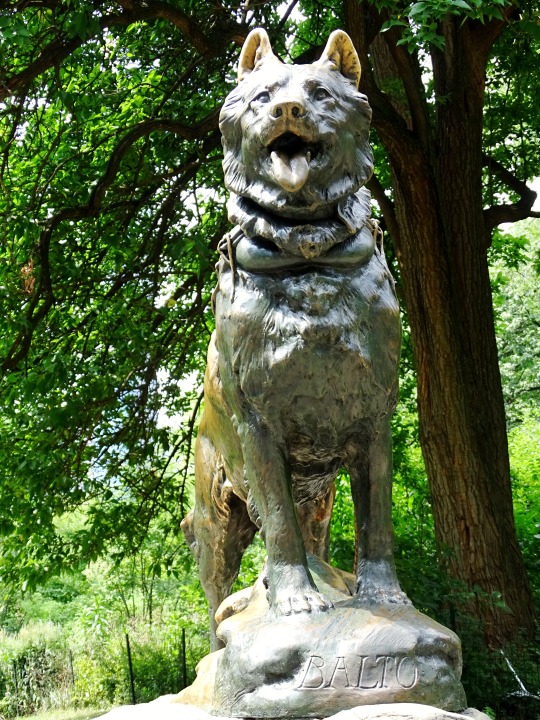





National Sled Dog Day
High-energy, furry athletes powering through snow and ice — a testament to teamwork and nature's endurance champs.
Running through snow all day, every day, pulling a sled that can weigh hundreds if not thousands of pounds—that’s a sled dog’s job. Don’t you think they might deserve a little recognition? February 2nd is the official holiday of the sled dog that we can safely say man would not have managed very well at all without.
The History of National Sled Dog Day
Sled dogs are thought to have evolved in the mountainous regions of Northern Asia over 35,000 years ago, but are thought to have started actually pulling sleds for people about 3,000 years ago, when hunting and fishing communities were forced to move further up north to Siberia. From there, they made their way to Lapland, Alaska, Canada and even Greenland. Historical references to actual dog harnesses far outdate the first European contact with the native peoples of Alaska and Canada.
In fact, it was the Alaskan gold rush that really got the American population interested in the use of sled dogs as a form of transportation, as most gold camps were only accessible by dogsled in the winter months. In fact, for a long while, dogsleds were the only relatively dependable way of transporting anything in the harsh Alaska and Yukon weather conditions, until airplanes finally took over in the 1930s. Dogsleds were also used to patrol western Alaska as late as World War II. After that, mushing became largely recreational. One of sled dogs’ most impressive achievements was the 1925 serum run from Nome to Nenana. With a diptheria threatening the lives of people in Nome and the serum needed being 1,100 kilometers (700 miles) away in the town of Nenana, hundreds of people may have died if not for the 20 dogsled teams that worked together to relay the serum to Nome. In the end, the serum reached Nome in only 6 days, saving the lives of many. Also, the first Arctic explorers were men with sled dogs.
How to celebrate National Sled Dog Day
Sled dogs are also celebrated for their role in polar expeditions, and a number of famous dog races are organised each year. National Sled Dog Day is an opportunity to raise awareness of the animals’ dedication to the human race. It can also be a time to raise money for dog charities taking care of homeless, or sick dogs, and those that have been cruelly abandoned by their owners. There are also numerous opportunities to volunteer at your local animal shelter to spend time with some of the dogs living there, play with them, or take them out for walks.
Dogs are generally social, friendly creatures that love physical activity and playing games, so even the smallest gesture on your part to celebrate National Sled Dog Day will definitely be greatly appreciated by a dog that has nothing to do but sit in a cage or pen all day, every day.
Who knows, maybe you’ll become friends and you’ll decide to adopt the dog? That would be the ultimate gesture of respect towards the sled dogs that sacrificed their health and sometimes their lives, for the good of men.
Organizations like PETA take the opportunity to point out how many dogs are being abused and mistreated in the world and encourage people to take action if they happen to witness any kind of abuse being perpetrated on man’s best friend.
PETA is also strongly opposed to the runs that take place in Alaska every year, saying they exhaust the animals for no good reason, and implore of Alaskan tourists not to patronize the Iditarod annual commemorative race, or any tourist attractions that include dogsled rides.
Source
#Whitehorse#Yukon#Balto by Frederick George Richard Roth#Stampeder Statue by Peter Lucchetti#Skagway#Central Park#New York City#USA#Canada#Seattle#Regina#RCMP Heritage Centre#Klondike Gold Rush - Seattle Unit#National Sled Dog Day#travel#original photography#vacation#tourist attraction#landmark#cityscape#architecture#NationalSledDogDay#2 February
6 notes
·
View notes
Text
was reminded again about how much i HATE the shows names for the mikaelsons bc they DON’T MAKE FUCKING SENSE FOR 10TH CENTURY NORSEMEN. So i’m gonna throw out here the names i used for them on my very short lived klaus and elijah blogs (burn out is real lol). the idea here was that these were their names they were given/born with which they later change around to the ones we know them by to you know, keep up with the times a lil better.
first off the last names are now MíMISSON and MÍMISDÓTTIR because tHaT’s HoW nOrSe LaSt NaMeS wOrK.
Mímir = Mikael
Mímir is a famous character in Scandinavian myth. He was a wise man and advisor to Odin who was decapitated in the Æsir–Vanir War. Odin did some witchcraft to preserve his head and now keeps it in the well at the bottom of Yggdrasil and asks him shit. It just feels like the kinda thing parents would name their kid with optimism he’d grow up Wise and favored by Odin but then he turns out Like That. Picks Mikael later on because he would be the time to associate himself with a divine messenger warrior angel who 1v1′d Satan. The prick.
Eistla = Esther
Frankly the one I’m least likely to actually USE the canon name for outside of meta and general fandom talking and only for clarity reasons. Since she died in the 10th century and isn’t around again until the 21st century for a hot minute there’s really no need to figure out a new name for her. Derived from “Eist/Oast” which means like “Pyre/Embers/Fire/Etc” also the name of Jotunn.
Freya = Freya
No notes for obvious reasons. Fun fact tho, Freya is just the feminine form of Freyr which means “Lord/Master” or “Fertile” which tracks with how both Freya and Freyr are associated with fertility. Freya is the Vanir goddess oflove, beauty, fertility, sex, war, gold, and seiðr (magic for seeing and influencing the future) so I mean, she’s very accurately named lol.
Finnbjǫrn = Finn
Honestly again another dude who didn’t really change his name because he was in a box for 900 years but also lucked out that Finn’s both a nickname for his own name and like, A Normal Ass Name to this day. Finn usually refers to Finland/Lapland and björn/bjǫrn means “bear/warrior”. Which like honestly, yes so real, such vibes for my specialest boy.
Eylaugr = Elijah
Eylaugr is the male form of Eylaug and is built from “Ey” which means “island” or “floodplain” and Laug which in old germanic means “to celebrate marriage/to swear a holy oath/to be dedicated” and is likely related to the old Norse “Laug/Log” which means “bath (in connection with religious worship)”. Likely picked Elijah due to the auditory similarity to help with like, fucking remembering it and responding to it (honestly a major factor for all of them lbr) but also keeps the holy vibes aesthetic since Elijah is a prophet and miracle worker and I think he’d appreciate that through line of like, aesthetic continuity.
Næskunungr = Nikalus
Combination of “Nes” (ness/spit of land) and “Konung” (king). Old Norse neskonungr = 'ness-king', 'small-king'; one who has no more than a ness over which to rule. Which like, god SUCH A BURN EVEN FROM YOUTH. I’d just been looking for something that sounded reasonably close to “Niklaus” on an auditory level but then I saw the breakdown of the parts and was like “oh yeah, that’s Klaus”. Like you could see it as parents being like “aw little king baby :)” or “look at this napeleon complex motherfucker even before napeleon complexes are a THING” and I think that’s beautiful. Goes with Niklaus later because again, reasonably close to Næskunungr in sound and also means “Victor of the people” and I mean...... Yeah.... He’d do that.....
Ragrifridr/Ragnfríðr = Rebekah
Built from “regin” (advise/decision/might/power (of the gods) ) and “fríðr” (beautiful/beloved/good/alive/peaceful/safe). She absolutely picked it for the sound and vibes and nothing else but it does mean “Moderator, To Tie, Noose, To Bind, Captivating, Strong Combatant, Hearty”. Which does feel very good for her so like, 10/10 on that front
Kolr = Kol
Again another one who gets no notes. Stunning, perfect, flawless. Kol/Kolr in old Norse just means “coal” so like, lol okay I see we gave up around here I guess.
Heðinn = Henrik
Heðinn means “jacket of fur or skin” in Old Norse. I’ve already given some leeway in places like Finn’s name which is more finnish than it is norwegian but I gotta draw the line somewhere and I’m doing it at Henrik’s german ass name. Again another one who would’ve never used their canon name because he’s Fuckin’ Dead. Tried to pick something was from the right rough area and sounded similar enough and then I saw the meaning of this name and was like “oh that’s some nice foreshadowing if I’ve ever seen it”.
BONUS ROUND--
Since I’m the boss now and say that Sage is from the same time period here’s a more timeline appropriate name for her too
Sannhild = Sage
Built of the Old Norse: sannr (true/truthful) and “hildr” (battle/fight). Mainly picked for the auditory closeness to Sage and vibes.
#mikaelsons#meta#tvdu#sage tvd#it's my blog so i get to put in the effort that the writers actively refused to put in
48 notes
·
View notes
Text
To the rest of the world, Finland is often held up as a beacon of progressivism. Various international indices have ranked it among the world’s most stable, best governed, least corrupt, and most socially progressive countries on earth. But the parliamentary antics surrounding recent efforts to reform the country’s Indigenous law are likely to shatter any illusions that Finland is either well-governed or progressive.
The Indigenous Sámi people are native to Arctic Europe and number approximately 80,000 across Norway, Sweden, Finland, and Russia. In Finland, they are represented by a constitutionally recognized Indigenous assembly known as the Sámi Parliament. Working with the national Finnish parliament, the self-governing body has the power to propose and consult on legislation that affects Indigenous cultural practices in the country, though it does not have veto power over these measures.
Or—at least it is supposed to be self-governing. Sámi visions for their parliament were diluted in negotiations to create the body in the 1990s. And since 2011, the Finnish Supreme Administrative Court—which includes no Sámi members—has also repeatedly overruled the Sámi Parliament’s decisions on who should be eligible to vote in elections to the body. In practical terms, this means the court has decided who in Finland can be considered Indigenous—admitting claimants who many Sámi say have a spurious connection to their community.
Last year, the United Nations ruled that those legal verdicts were in violation of international law because they deprived Finland’s Sámi community of the right to self-determination. The U.N. opinion put Finland’s international reputation at risk and supercharged efforts within the country to reform the Sámi Parliament Act, the law that governs the body.
Even before the U.N. ruling, reforms to clarify who is eligible to vote in Sámi elections and their consultative rights had become a central concern of Finnish Prime Minister Sanna Marin, who called updates to the Sámi Parliament Act “one of the most important human rights issues facing Finland.” Both in her government’s 2019 platform and during a visit to the Sámi capital of Inari in June last year, she promised to see the act reformed. And in November 2022, with limited time left in her legislative term, Marin even forced a draft reform bill to parliament over the objections of her coalition partners—contravening long-held norms in Finnish politics that coalition governments only act with unanimity.
But in the months since, the reforms have become the center of a vicious culture war, pitting the tiny Sámi Indigenous community and its allies against the forces of Finland’s rural and reactionary right. Marin’s attempt at reform fell victim to this conflict—stymied last month by an alliance between her conservative coalition partners and critics within her own party, who deployed political chicanery and strategic absences to kill the bill in committee.
It was a personal embarrassment for Marin, who could not maintain the cohesion within her party necessary to pass a key piece of legislation and who now faces an uphill battle to win reelection in an April 2 vote that is seeing a resurgence of Finland’s nativist far right. It was also an escalation of a long-simmering conflict that may come to dominate the agenda of Finland’s next government.
Finland’s Sámi community is the smallest of the three Nordic countries, numbering around 10,000 people. They have lived for millennia across a broad region of Arctic Finland known as Lapland. Finnish colonization of Lapland began in the 16th century, and Sámi were quickly outnumbered in many of their own communities by Finnish settlers known as Laplanders. To survive the rugged terrain, Laplanders adopted many of the livelihoods that defined Sámi culture, such as hunting, fishing, foresting, and reindeer herding.
For centuries, colonial governments forced discriminatory and assimilationist policies upon Sámi. In church- and state-run boarding schools, Sámi children were prevented from using their native language, while Sámi communities were often forcibly relocated for the construction of dams and reservoirs. Politically, Sámi had little recourse—a tiny minority in their own homeland, they were subject to the whims of colonial governments.
That began to change in the 1990s. Amid a growing international push for Indigenous rights, Sámi activists lobbied Helsinki to form the Sámi Parliament and create an autonomous Indigenous government for their community. The campaign was immediately met with strong objections from Laplanders, who saw any advancement of Indigenous rights as an infringement on their own.
In 1995, the Finnish government succeeded in passing the Sámi Parliament Act, which created the Sámi Parliament and formalized its consultative role in Finland. But in the almost 30 years since, it’s become clear that the law was deeply tainted by compromise with the Laplander majority, who occupied the steps of parliament to oppose special rights for their Sámi neighbors.
The act provides two ways for a person to define themselves as Sámi. The first is a connection, within three generations, to someone who spoke a Sámi language as their first language. Other Nordic countries use this definition to delineate their Sámi communities, and Sámi leaders say it is the most accurate.
But the act also allows for a second definition of Sámi identity known as the “Laplander criteria.” This makes eligible for Sámi status anyone with an ancestor who practiced a rural livelihood such as hunting, foresting, or fishing in Lapland, as registered in records going back to the 16th century.
Hannele Pokka was Finland’s justice minister when the Sámi Parliament act was drafted and today serves as a member of the country’s Truth and Reconciliation Commission. She told Foreign Policy that the Laplander criteria definition was written to satisfy a Laplander constituency that wanted the same legal protections for their historical cultural practices as those afforded to the Indigenous group.
The Laplanders were animated by a fierce opposition to exclusive rights for Sámi—in particular, fears that the Sámi Parliament would gain veto rights over unwanted economic development projects in Lapland. In recent years, Sámi territory has been increasingly targeted for logging, mining, and green energy projects, often over the objections of Sámi leadership.
“The people who were against this act … wanted to be some kind of original Lappish people who have [their own] rights,” Pokka said.
But after the creation of the Sámi Parliament, that strategy changed. “I met these people, who were protesting on the stairs of Parliament House in 1995 … opposing Sámi rights,” said Kukka Ranta, a Finnish doctoral researcher and author who has written extensively on Finnish-Sámi relations. After the parliament was created, she said, “these very same people tried to get access to the Sámi Parliament.”
In the almost three decades since the body was created, these Laplander groups have succeeded in muddying the waters of Sámi identity itself (in the eyes of the Finnish majority, at least—Sámi themselves have little doubts about who qualifies as Sámi). Since 2011, with the help of the Supreme Court decisions, the groups have gained voting rights to the Sámi Parliament, electing members who oppose efforts to expand Sámi land rights and contain private developments in their Arctic territory.
Many Sámi fear that, without reforming the act, their own institutions may become captured by forces opposed to the traditional Sámi way of life. “It could be that the Sámi have to start protesting [their] own parliament and claiming that it doesn’t represent the Sámi view anymore,” said Petra Laiti, a Sámi youth activist from Inari. “If that happens, that’s going to be a whole mess of a situation.”
Marin’s reforms would have strengthened requirements for resource companies and the Finnish government to consult with the Sámi Parliament on projects in Lapland. It would have also removed the Laplander criteria. Some critics went so far as to call the latter proposal an attempt at ethnic cleansing.
This combination of targets ultimately made for a powerful alliance between reactionary rural Laplander groups and the landed interests of Finland’s north. Both are represented largely by the Centre Party—the coalition partner of Marin’s Social Democrats, which threw up the biggest roadblocks to reform. Ultimately, however, it was members of Marin’s own party with connections to Laplander groups and industrial interests who conspired to ensure the bill’s failure.
The outcome leaves the Sámi community and its allies within Marin’s coalition in a tenuous position. The Sámi Parliament has moved to eject Laplander voters admitted by the Supreme Court before its own election in the fall. But it’s not yet clear whether that decision will also be challenged in court.
Marin and the Social Democratic Party still have the support of many Sámi activists, but they appear poised to lose power in this Sunday’s election. Few politicians have felt the need to comment on the failure of a reformed Sámi Parliament Act on the campaign trail, focusing instead on climate change, immigration, and NATO membership. Polls have recorded surging support for Finland’s nativist party and others in the center-right.
Many Sámi say they have little choice but to continue fighting for reform to the Sámi Parliament Act. But it’s anyone’s guess who will be sitting opposite them at the negotiating table after Sunday’s election. Finland’s debate over Sámi issues has unleashed a community vocally opposed to progress on Indigenous issues—and may well push the whole country further to the right.
20 notes
·
View notes